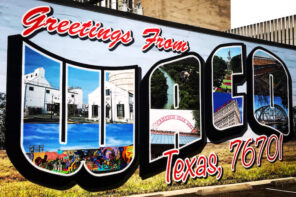In an early scene that establishes the backstory for Martin, the teenage narrator of Stake Land, there’s no mistaking the fact that the film fits squarely into the grisliest corner of the horror genre. Martin’s family is on the road and has sought shelter in a lonely barn at nightfall as a radio announcer warns listeners to beware of a vaguely defined but deadly menace. When Martin (Connor Paolo of Gossip Girl) ventures into the darkness after his dog dashes away, he encounters Mister, a vampire-hunter who has tracked his quarry to the spot where Martin’s fortunes are about to turn. The pair edge back into the barn, tense as Marines inspecting a hovel in Falluja, to find that one of the carriers of an unstoppable vampire-zombie plague has already made a sloppy meal of Martin’s parents, and his infant sister dangles from the creature’s jagged maw.
“I’m not a normal boy anymore,” Martin tells the audience as the film spools forward a few months to one of his daily vampire-slaying lessons with Mister (played with gruff but tenderhearted authority by Nick Damici). “It’s not a normal world.”
The Dramatic Possibilities of Horror
If bloodthirsty undead zombie action isn’t usually your thing, you might be temped to pass on Stake Land. But like Danny Boyle’s 28 Days Later and Let the Right One In, the brilliant reworking of vampire tropes by Swedish novelist-screenwriter John Ajvide Lindqvist, Stake Land upends many of the expectations moviegoers are likely to bring to a genre film. It also makes grimly imaginative and occasionally audacious use of some of the religious and political themes threading through contemporary American culture.
Stake Land director Jim Mickle, who co-wrote the script with Damici, traces his appreciation for the possibilities of horror-film storytelling to an “ah-ha” moment he had while watching the camp-horror classic Army of Darkness when he was 13.
Mickle said that as he tracked the choices and improvisations at play behind the progression of shots and images, “I realized the people who had created it were really having fun.” That realization led Mickle from rural Pennsylvania (where many of the early scenes in Stake Land were shot) to film school at New York University. Unlike other young filmmakers, who often see the horror genre as a stepping stone to what they consider more serious work, Mickle’s ambition in Mulberry Street, his first feature, and now in Stake Land is to prove the horror-film’s value as a medium for old-school dramaturgy.
“I see genre as a context for telling bigger stories,” he said. “That means connecting the melodramas within the drama to the real world, then exploring those narratives through a more intense, heightened reality.”
Fear and paranoia were the specific realities that Mickle and Damici found themselves weaving into the script when they began the project in the fall of 2008.
“When we originally started, the story was set in the present day,” Mickle said. “Then leading up to the election, there was such a pronounced divide in the country, and we knew we wanted it to be relevant, larger than just a guy and a kid.”
Backwoods Apocalypse
The true source of tension in the film thus shifted from the vampire-zombies themselves to violent-minded religionists who see an apocalyptic plague in the near future as the hand of God wiping clean the sinful culture of a chosen nation.
“Our intention in making that choice wasn’t about a specific religion,” Mickle said. “It was about fanaticism as the driver of conflict. How does that kind of conflict get reconciled? We took the nihilist approach: it can’t be reconciled.”
Thankfully, that nihilism takes a greater toll on the characters in Stake Land than it does on the viewer. While Martin, Mister and the other survivors they encounter must endure the onslaught of the Brotherhood—a radicalized Christian cult that commandeers aircraft from which to drop captured vampire-zombies into the last redoubts of civil order—they also pass through rural landscapes that have begun to reclaim the wild beauty that human civilization tends to suppress.
Mickle connects the decision to set the film’s vision of the apocalypse in the backwoods rather than “giant rubble cities” to the influence of post-human naturalism in media fare like Alan Weisman’s The World Without Us and the History Channel’s Life After People.
“I fell in love with idea that the future is going to look more like the past,” he said. “Now there’s branding everywhere, our lives are filled with so much text. Once that’s gone, the environment dramatically changes. It becomes otherworldly, but not: It’s just grass and trees.”
And ultimately it’s the strand of belief that coexists with an appreciation for natural wildness that prevails by the end of the film. One of Martin’s and Mister’s fellow travelers is Sister Anna (Kelly McGillis), a nun whose long-suffering kindness balances the Brotherhood’s brutality. Anna embodies what Mickle calls “the beautiful side of religion,” which seems likely to take root in the place called New Eden where the remnants of humanity in Stake Land finally find refuge.




